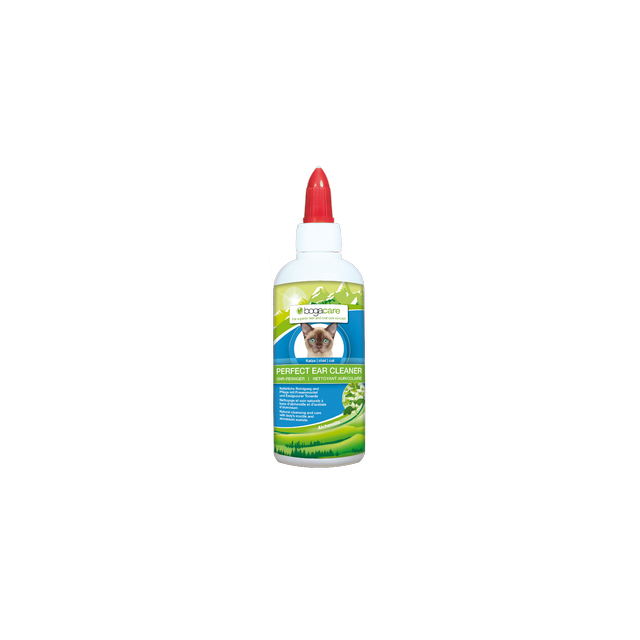Ear infection in cats
It's not very common for a cat to have an ear infection. But when a cat does have an ear infection, it's often difficult to determine the exact cause, and treatment can be challenging. Pharmacy4pets helps you identify ear problems and offers a wide range of care products.
Causes of Ear Infection in Cats
Just like dogs, cats with an allergy also frequently suffer from itching in the ears and/or an ear infection.
In dogs, it's almost always primarily the external auditory canal, or the outer ear, that is inflamed. This is called otitis externa. In cats, the infection often goes deeper, into the middle ear. A middle ear infection (otitis media) can occur if the eardrum ruptures and the inflammation of the auditory canal reaches the middle ear in this way. However, what often happens in cats is that inflammation of the nose and/or throat, usually as part of the feline upper respiratory infection (cat flu), climbs via the Eustachian tube (the connection between the nasal/throat cavity and the middle ear) to the middle ear. Then you see nothing on the ear flap and the auditory canal, but the cat still has an ear infection, making it much harder to detect!
An ear infection can also arise from an obstruction of the auditory canal: there's something in the auditory canal that doesn't belong there. This could be a foreign object, such as a grass seed, but also middle ear polyps or tumors. Middle ear polyps are benign, mushroom-shaped swellings of inflammatory tissue that form in the middle ear and sometimes grow through the eardrum into the auditory canal. It is thought that these polyps arise due to chronic irritation of the mucous membrane by an upper respiratory tract infection (cat flu). Parasites, ear mites, can also cause an ear infection. Ear mites are especially seen in kittens, farm cats, and stray cats. Ear mites are highly contagious and itch terribly.
Symptoms of Ear Infection in Cats
Symptoms of otitis externa are often recognized by an owner as a sign that something is wrong with the ear. The symptoms of a middle ear infection are less clear and sometimes even outright vague. As a result, it can sometimes go unnoticed for a long time. Symptoms of ear infection in cats:
- Itching of the ears.
- Shaking the head.
- Holding the head tilted or one ear flat.
- Crusts, flakes, wounds, or bald spots on or around the ear.
- Dirty ears.
- A visible pink swelling in the auditory canal.
- Balance disorders (for example, tilting head position, inability to jump, staggering, falling over, walking in circles).
- Unequal pupils or other asymmetry of the head (for example, drooping eyelids, visible third eyelid, deeper set eye): Horner's syndrome.
- Vague symptoms such as being lethargic, eating less, withdrawing.
- Not responding to sounds.
Treatment of Ear Infection in Cats
As discussed earlier, it can be difficult to determine the cause of a cat's ear infection (sometimes even a CT scan is needed!) and therefore treating an ear infection can be frustrating. The appropriate treatment, of course, depends on the cause.
Treatment of Otitis Externa in Cats
If your cat's auditory canal is inflamed, it is usually treated with an ear ointment containing antibiotics, an antifungal agent, and/or an anti-inflammatory. Very mild cases of ear infection can be treated with honey-based ear drops: Dermiel ear drops.
If an allergy is the cause of the ear infection, hypoallergenic food, for example, Sanimed Skin/Sensitive, may be advised, as well as allergy medication. Sometimes painkillers and/or antibiotics are necessary.
Treatment of Middle Ear Infection in Cats
It is not possible (and even dangerous!) to treat a middle ear infection with an ear ointment. The problem must be addressed from the inside. Often this means long-term treatment with antibiotics, painkillers/anti-inflammatories, and sometimes medication for nausea (due to dizziness). Sometimes surgery is necessary.
Treatment of an Obstruction of the Auditory Canal
Foreign objects can usually be removed under sedation. Middle ear polyps and tumors must be surgically removed.
Treatment of Ear Mites in Cats
Ear mites can be treated with ear ointment Otimectin (only give if the eardrum is not damaged, so a visit to the vet to check this is important!) and/or a spot-on between the shoulder blades.
Cleaning Your Cat's Ears
Cat's ears are supposed to be a bit greasy; this helps to catch pathogens. The ear canals clean themselves. Therefore, in most cases, cleaning your cat's ears is not necessary. Cleaning the ears too often or using the wrong products can do more harm than good. If your cat really has dirty ears, use a product designed for the ear canal to prevent irritation. Safe ear cleaners include Epi-Otic ear cleaner and Monoclean. Ear cleaners should only be used if the eardrum is intact.
Fortunately, ear infections in cats are not very common. However, if your cat has an ear infection, it can be quite persistent and, especially if it occurs in the middle ear, is often discovered late. If you suspect an ear infection, it is important to contact your veterinarian.
Pharmacy4pets helps you keep your cat's ears clean and healthy. If you have a question about our products or about your cat's ears, please contact us.

